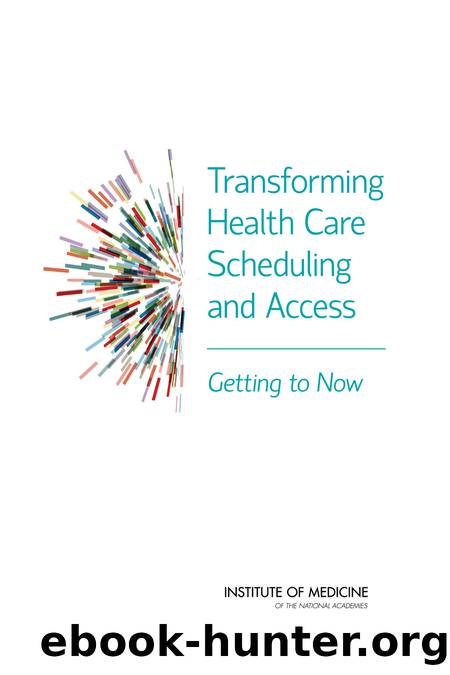Transforming Health Care Scheduling and Access: Getting to Now by Gary Kaplan

Author:Gary Kaplan
Language: eng
Format: epub
Tags: ebook, book
Publisher: The National Academies Press
Published: 2015-09-02T00:00:00+00:00
Engaging Patients and Families in Systems Design and Implementation
As has been emphasized throughout this report, the committee recognizes that it is important for patients to be core partners in systems redesign. Studies have shown that patientsâ active management of their own health care is associated with the patientsâ greater satisfaction with their care and with better health outcomes, quality of life, and economic outcomes (Hibbard and Greene, 2013; IOM, 2013). However, as noted in Chapter 1, providing patient-centered care goes beyond consideration and concern in direct care. It requires a delivery system that supports the provision of care that meets patientsâ needsâand thus one that integrates patient values, experiences, and preferences into the design and governance of the health care organization. Designing such a system requires engaging patients in organizational design and governance as well as in their direct care (Carman et al., 2013).
With regard to scheduling and access, as described in Chapter 3, a patient-centered health care system understands its inherent capacity, patient demand, and variations in this supply and demand; this leads to a system that performs at its optimal capability, including with minimal delays, but that is also sufficiently flexible to handle temporary fluctuations in either its provider supply or patient demand. Engaging patients in the assessment, design, and improvement processes can lead to a better understanding of patient demand and thus how the system can be realigned to meet that demand.
Simply implementing an advanced scheduling system is not a patient-centered action unless it strengthens the patientâclinician partnership, promotes trust and collaboration, and facilitates the patientâs involvement (Davis et al., 2005). To assess patient experiences and patient satisfaction, including with access and scheduling, health care organizations can use and analyze survey data concerning patient experience and satisfaction, such as data from the Consumer Assessment of Healthcare Providers and Systems (CAHPS) surveys that were described in Chapter 1. These data can then be used to identify areas of waste or delays and also to inform access improvement activities such as process redesigns. The implementation of partnerships with patient advisors and the development of patient and family advisory councils have proven to be effective ways to gather this essential information; however, other methods are needed to evaluate the patientâs ability to obtain ambulatory and office-based appointments quickly.
Currently, little information exists on the effects of patient involvement in access-related improvement activities on either operational or health care outcomes. However, areas in which patients could be included in efforts to improve access and optimize scheduling may include: defining preferences, exploring alternative access strategies, contributing to the design of pilot improvement efforts, helping to shape communication strategies, and interfacing with governance and leadership. Box 4-12 describes how Seattle Childrenâs Hospital incorporated patient and family needs and preferences when designing its scheduling approach.
Additional opportunities to engage patients in scheduling and access include increasing transparency and communication through publishing wait times data and developing information systems to support communication about scheduling and future care needs. Currently, few data are available to patients regarding wait
Download
This site does not store any files on its server. We only index and link to content provided by other sites. Please contact the content providers to delete copyright contents if any and email us, we'll remove relevant links or contents immediately.
Introduction to Social Work Practice : A Practical Workbook by Herschel Knapp(284)
Selective Oxidation Catalysts Obtained by the Immobilization of Iron (III) Porphyrins on Layered Hydroxide Salts by Fernando Wypych Shirley Nakagaki & Guilherme Sippel Machado(276)
How Data Happened by Unknown(267)
Global Health Governance and Commercialisation of Public Health in India by Anuj Kapilashrami Rama V. Baru(220)
Unmasked by Emily Mendenhall(183)
Curing Cancerphobia by David Ropeik(174)
The Pandemic Divide by Gwendolyn L. Wright Lucas Hubbard and William A. Darity Jr(160)
Feminist Global Health Security by Clare Wenham(149)
Restoring Quality Health Care by Scott W. Atlas(147)
FALSE PANDEMICS: ARGUMENTS AGAINST THE RULE OF FEAR by Wolfgang Wodarg(147)
Transforming Health Care Scheduling and Access: Getting to Now by Gary Kaplan(142)
Oversight and Review of Clinical Gene Transfer Protocols: Assessing the Role of the Recombinant DNA Advisory Committee by Rebecca N. Koehler(141)
The Making of a Pandemic: Social, Political, and Psychological Perspectives on Covid-19 by John Ehrenreich(140)
Pandemic India by Arnold David;(139)
The Metropolitan Academic Medical Center by David E. Rogers Eli Ginzberg(128)
Insane Society: A Sociology of Mental Health by Peter Morrall(128)
Into Africa, Out of Academia by Kwan Kew Lai(127)
Risk Communication and Infectious Diseases in an Age of Digital Media by Anat Gesser-Edelsburg Yaffa Shir-Raz(126)
Psychosocial Interventions for Mental and Substance Use Disorders: A Framework for Establishing Evidence-Based Standards by Mary Jane England(126)
